Tags
Austria, Blessed Konrad II, Germany, reliquary, Saint Rupert, Saint Virgil, Salzburg, Salzburg Cathedral, skeleton
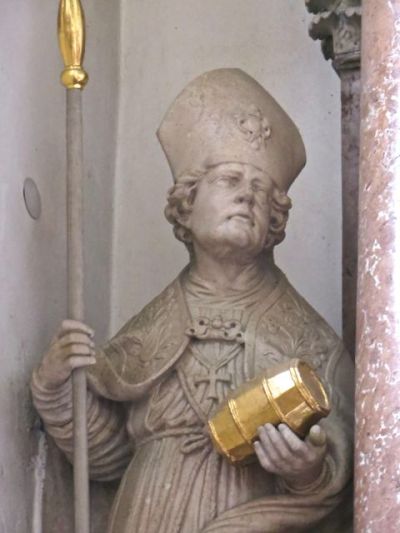
Statue of Saint Rupert (detail), Collegiate Church of Saint Peter and Saint John the Baptist (Stiftskirche St. Peter und Johannes der Taüfer), Berchtesgaden, Germany
Salt of the Earth
In his wide-ranging history of salt, Salt: A World History, Mark Kurlansky retells the story of a French princess who infuriated her father by declaring she loved him like salt. “Only later,” Kurlansky writes, when the king “is denied salt does he realize its value and therefore the depth of his daughter’s love.”[1] Because salt is “so common, so easy to obtain, and so inexpensive,” Kurlansky explains, “we have forgotten that from the beginning of civilization until about 100 years ago, salt was one of the most sought-after commodities in human history.”[2] Salt was so precious, Roman soldiers were once paid an amount of money for the purchase of salt, known as a salarium — that is, a “salary.”[3] Salt was also fundamental to the growth of several European cities, including the great city of Salzburg, Austria. The name “Salzburg,” in fact, derives from the German word for salt (Salz) and the word for castle (Burg).

View of Hohensalzburg Castle from Mirabell Palace and Gardens, Salzburg, Austria
The rise and development of Salzburg, however, was far from inevitable. By the 7th century, the city, then known as Juvavum, was in ruin following the collapse of the Roman Empire and the catastrophic breakdown of public infrastructure throughout the region.[4] The work of an enterprising saint, and a little bit of salt, however, helped revive Salzburg’s fortunes. The saint was Saint Rupert, first Bishop of Salzburg, whose likeness appears throughout the city and region to this day. He is commonly portrayed carrying a vessel of salt, his traditional emblem in art — and an apt attribute for the patron saint of the Salt Castle.
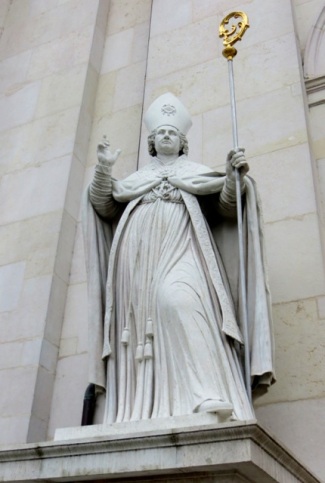
Statue of Saint Rupert, Salzburg Cathedral, Salzburg, Austria
Man of Salt
Who was Saint Rupert, and why is he so closely associated with Salzburg? According to Butler’s Lives of the Saints, Saint Rupert was either a Frank or an Irishman who had once been Bishop of Worms.[5] In approximately 697, Saint Rupert and several companions traveled to Regensburg to visit Duke Theodo of Bavaria, a powerful ruler “without whose permission nothing much could be done.”[6] Saint Rupert eventually converted and baptized the duke, who afterwards became Saint Rupert’s patron. With the duke’s support, Saint Rupert reestablished Christianity along the Danube, in an area stretching from Regensburg to Lorch.[7]
Instead of settling in either of these places, however, Saint Rupert chose to establish himself in the “old ruined town of Juvavum.”[8] Juvavum contained a number of Roman-era buildings, though most were “dilapidated” and “overgrown with briars and brushwood.”[9]. The ancient town’s main advantage was its location in a prospering commercial area, in a region rich in salt.

Statue of Saint Rupert, Cemetery of Saint Sebastian, Salzburg, Austria
Saint Rupert petitioned Duke Theodo for the territory of Juvavum, and the duke readily agreed. Soon after, Saint Rupert erected the town’s first church, the Church of Saint Peter (Stiftskirche Sankt Peter), at the base of the Mönchberg.[10] He also established the town’s first monastery and its first convent, Nonnberg Abbey, whose first abbess, Saint Erentrude, was Saint Rupert’s niece.
Part of Duke Theodo’s original donation included rich salt deposits, which were mined for their precious crystals.[11] Saint Rupert is credited with establishing these first salt mines, which would become a source of the city’s great wealth and grandeur in later centuries.[12] As the city prospered, wealth from salt mining enabled the arts to flourish. Today, however, the influence of salt on the city’s growth and prosperity has been all but forgotten. Instead, Salzburg is celebrated as an elegant city of music, the birthplace of Mozart and, more recently, the backdrop of the perennially popular movie The Sound of Music.
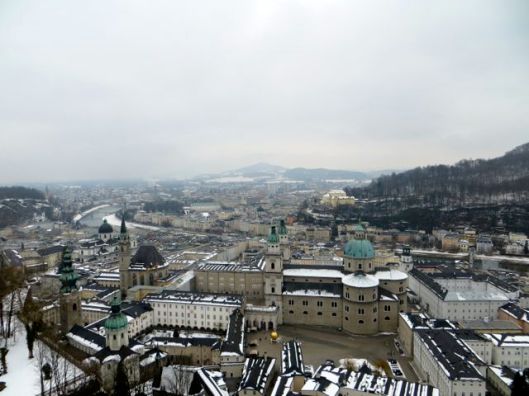
View of Salzburg from Festung Hohensalzburg. Salzburg Cathedral, with its distinctive green dome, is visible near the center of the photograph.
Skeletons at the von Trapp Wedding
Located 17 miles east of Salzburg, in the charming lakeside town of Mondsee, Austria, the parish church of Saint Michael (Pfarrkirche St Michael), is the second largest church in Upper Austria. Built in the late 15th century, the twin towers and pale yellow of the church’s exterior may strike some as vaguely familiar. As it turns out, the church served as the setting of Fraulein Maria’s wedding to Captain von Trapp in The Sound of Music.

Parish Church of Saint Michael, Mondsee, Austria
The interior of the church features striking vaulted ceilings, a riot of carved and painted figures, and various gilded Baroque altars, including five by the famed Swiss sculptor Meinrad Guggenbichler.[13] The church also houses a number of relics, some of which make brief cameos in the wedding scene of The Sound of Music. The relics of Blessed Konrad II are the most notable. Located directly above the tabernacle behind the high altar, the seated skeleton of Blessed Konrad II, a 12th century abbott of Mondsee, peers out from behind a glass enclosed niche. The skeleton’s head is surrounded by a ray halo, and his left hand clutches a staff and palm frond, indicating a martyr’s death. Apparently, Blessed Konrad II was killed defending his monastery, and his fellow monks believed his murder qualified him for martyrdom.[14]
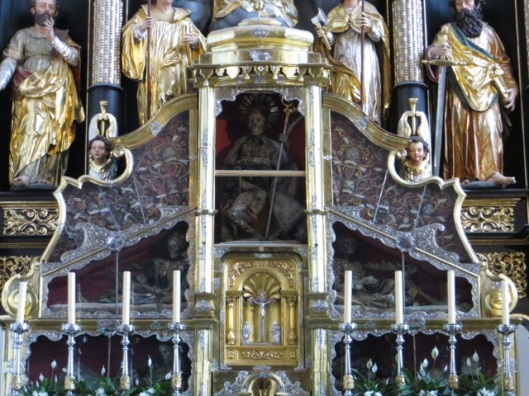
Seven-Part Reliquary with the Relics of Blessed Konrad II of Mondsee, Parish Church of Saint Michael, Mondsee, Austria
An array of other relics, carefully arranged in two large reliquary cases, are displayed to Blessed Konrad II’s right and left. The relics include various skulls and bones first collected and displayed in the church in the mid-18th century. Below the reliquary cases, four additional skeletons may be seen reclining in individual cases, two triangular and two rectangular. The skeletons look relaxed in their padded niches and observe the world as if from window of a passing train. The skeletons belong to catacomb saints exhumed and transported to Mondsee from the catacombs of Rome. The altar itself is a remarkable early Baroque work by the sculptor Hans Waldburger. Dating to 1626, the altar features a depiction of Saint Michael the Archangel placidly slaying a dragon. The altar is the only extant altar by Waldburger.[15]
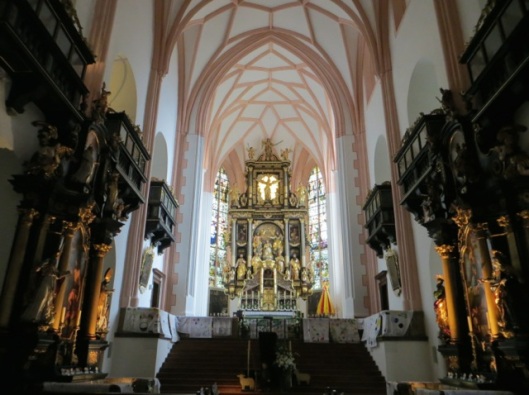
Parish Church of Saint Michael, Mondsee, Austria. The high altar, which dates to 1626, is the work of Hans Waldburger.
Salzburg Cathedral
Saint Rupert died in 710, and is buried in the crypt of Salzburg Cathedral. Consecrated to Saint Rupert and Saint Virgil in 774, the cathedral has been rebuilt and modified several times since its founding. In 1167, for example, the Counts of Plain, knights loyal to the the emperor Barbarossa, set fire to the cathedral, burning it virtually to its foundation.[16]

Salzburg Cathedral (Salzburger Dom), Salzburg, Austria
The cathedral was rebuilt, but burned again in 1598. The subsequent rebuilding effort, led by Salzburg’s archbishop at the time, Wolf Dietrich von Raitenau, outraged city residents who were shocked by Wolf Dietrich’s ruthless destruction of the cathedral’s cemetery, including the desecration of countless graves, for the rebuilding project.[17] After Wolf Dietrich was captured and imprisoned by Bavarian troops in a dispute over salt mining rights, Wolf Dietrich’s successor, Markus Sittikus von Hohenems, commissioned a new architect to complete the cathedral’s reconstruction.

Interior of Salzburg Cathedral (Salzburger Dom), Salzburg, Austria
Reconsecrated in 1628, the new, Baroque cathedral remained virtually unchanged until 1944, when a bomb crashed through the dome, destroying part of the chancel. After extensive renovations, the cathedral was consecrated a third time, in 1959. The three gates to the cathedral commemorate the three consecrations by displaying the years “774,” “1628,” and “1959” in gold above the portals.[18]
Back to the Salt Mines
Although Saint Rupert does not hover above the tabernacle of Salzburg Cathedral like Blessed Konrad II in Mondsee, images of Saint Rupert throughout the church and city serve as a reminder of his role in the city’s early history. As already noted, Saint Rupert is frequently shown carrying a vessel of salt, an acknowledgment of his influence on Salzburg’s salt trade. The container of salt, however, may hint at another of Saint Rupert’s accomplishments. In addition to establishing the city’s first salt mines, Saint Rupert was responsible for changing the city’s original name, Juvavum, to something more relevant and more enduring. The name he chose, of course, was “Salzburg,” the Salt Castle.
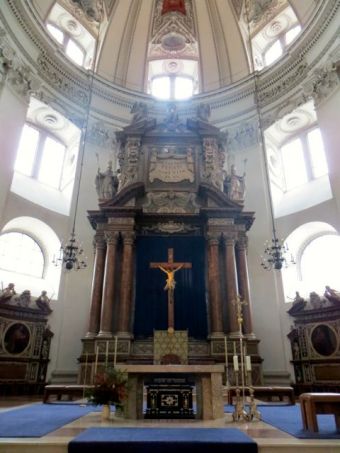
High Altar, Salzburg Cathedral (Salzburger Dom) Salzburg, Austria. Saint Rupert is depicted atop the altar carrying a barrel of salt in his left hand and a bishop’s crozier in his right. Saint Virgil is also represented atop the altar, opposite Saint Rupert.

Statue of Saint Rupert, Parish Church of Saint Andreas, Berchtesgaden, Germany

Interior of Dome, Salzburg Cathedral (Salzburger Dom), Salzburg, Austria. The dome was pierced by an aerial bomb in WWII. Repairs to the cathedral were not completed until 1959.
[1] Mark Kurlansky, Salt: A World History 6 (2002).
[2] Id.
[3] 2 Shorter Oxford English Dictionary 2653 (5th ed., 2002).
[4] Juvavum was one of the principle towns of the Roman frontier province of Noricum.
[5] 1 Butler’s Lives of the Saints 700 (Herbert J. Thurston, S.J. & Donald Attwater eds., 2d ed. 1956).
[6] Id.
[7] Id.
[8] Id.
[9] 13 Catholic Encyclopedia 229 (Charles G. Herbermann et al., eds 1912).
[10] Id. The church was established where Saint Maximus, a follower of Saint Severin, was martyred in 476.
[11] Id.
[12] Saleem H. Ali, Treasure of the Earth: Need, Greed, and a Sustainable Future 34 (2009).
[13] John Bourke, Baroque Churches of Central Europe 266 (1958).
[14] Blessed Konrad II of Mondsee, Saints.SPQN.com, available at http://saints.sqpn.com/blessed-konrad-ii-of-mondsee/.
[15] 10 Dictionary of German Biography 314 (Walther Killy et al., eds, 2006).
[16] Salzburg Cathedral, Salzburg Travel Guide, http://www.salzburg.info/en.
[17] Id.
[18] Id.

Pingback: CatholicSaints.Info » Blog Archive » Saint Rupert of Salzburg